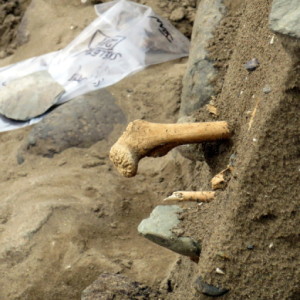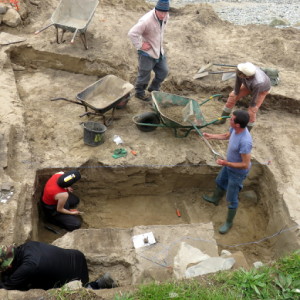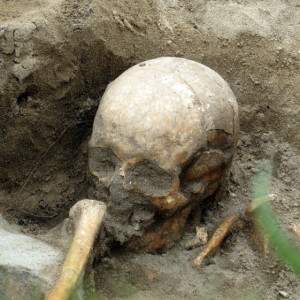'Bone-riddled ground'
The winter storms of 2014 washed human remains out of the ground at the top of Pembrokeshire's most westerly beach, Whitesands, Local police called in to investigate the skulls and bones that protruded from the bank, in turn called in archaeologists who are currently undertaking a rescue dig. The site was known to contain an early Christian burial ground and 80 skeletons dating from around 1000 years ago have now been excavated. Many of them belong to women and children including 2 infants buried together. They are mostly in cist graves, which are formed with stone slabs, and some include white pebbles and limpet shells. This skeleton seen here was being painstakingly exposed by the slow process of brushing away, or scooping with a spoon, the surrounding earth.
Shortly the dig will be filled in and the bones sent away for analysis. Their composition can tell us a lot about the health and diet of these people who may or may not have been local: some probably came from Ireland (for which this was an embarkation point) or from further afield.
Today was an opportunity for the public to learn about the excavation and to hear direct from the archaeologists details of the finds and what is known about the site (which would have been set considerably further away from the sea than it now is). There was a lot of interest and many questions were asked and helpfully answered.
Later, when a photo of the skeleton was put on Facebook, someone (in fact an archaeologist himself) expressed discomfort at human remains such as these being used for 'entertainment' on social media, and deplored what he feels to be an exploitative tendency in archaeology to titivate the public appetite for gruesomeness at the expense of respect for the dead. I wonder how others feel?
Personally I felt that the bones were being treated with a care that bordered on reverence, and they will safeguarded in future as significant sources of information, whether or not they will ultimately be re-buried. All the individuals involved, both diggers and spectators, were taking the the discoveries very seriously indeed.. One archaeologist spoke of her emotion at seeing the children's double grave.
However, unease about the ethics of studying human remains has caused considerable controversy in recent years with many such items being returned by museums to the countries or ethnic groups from which they were collected. Just recently a decision has at last been reached regarding the final destination of Kennewick Man, an important ancient skull discovered 20 years ago in North America and the subject ever since of fierce debate between scientists,for whom it represents crucial evidence about human dispersal, and indigenous people who regard 'him' as one of theirs, requiring reburial. It's not a cut-and-dried solution though: some tribal communities are actually keen to have their ancestral remains studied in order to throw light on their ethnic origins while others couldn't care less what happens to them.
Read more about it here if you want to judge for yourself.
More pics of the dig in extras.
Title from An Arundel Tomb, by Philip Larkin




Comments
Sign in or get an account to comment.


